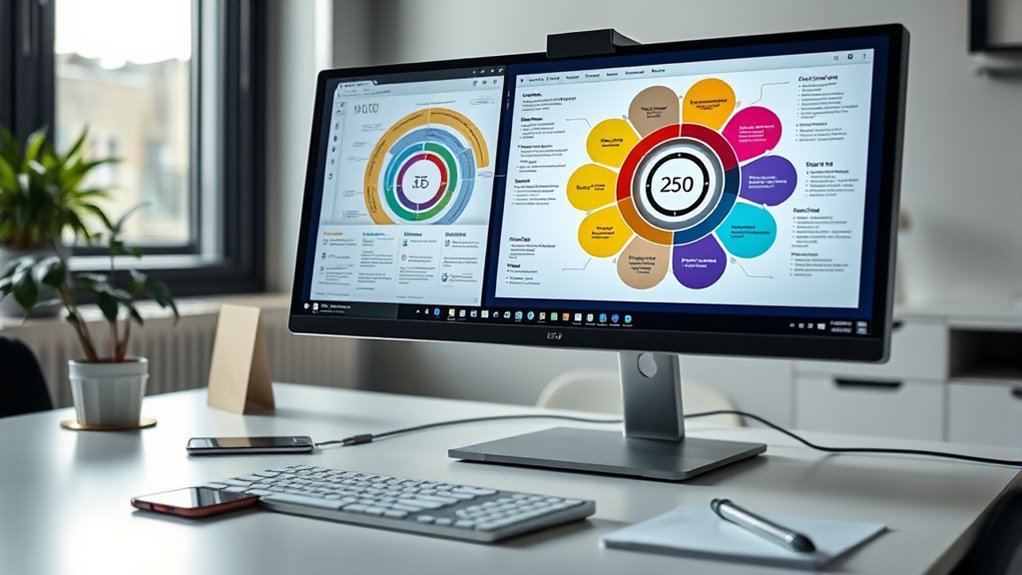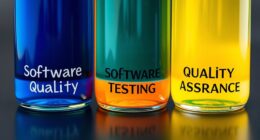The ISO/IEC 25010 software quality model provides a clear framework that helps you evaluate and enhance your software’s performance. It breaks down quality into key characteristics like functionality, usability, reliability, and efficiency, allowing you to measure how well your software meets user needs. Understanding these attributes helps you identify strengths and areas for improvement. Continue exploring, and you’ll discover how to apply this model to improve your software’s overall quality effectively.
Key Takeaways
- The ISO/IEC 25010 model provides a structured framework for evaluating software quality across multiple characteristics.
- It breaks down complex quality concepts into measurable attributes like functionality, usability, and reliability.
- The model emphasizes assessing how well software meets user needs and performs reliably.
- It highlights the interconnectedness of quality attributes, encouraging balanced improvements across characteristics.
- The framework supports targeted evaluation, continuous improvement, and compliance with industry standards.

Understanding the ISO/IEC 25010 Software Quality Model is vital for anyone involved in software development or quality assurance. This model provides a structured way to evaluate and improve software by focusing on key software attributes and quality characteristics. When you assess software, you’re fundamentally examining these attributes to determine how well the product meets user needs, performs reliably, and maintains its integrity over time. The model breaks down complex concepts into measurable qualities, making it easier for you to identify strengths and weaknesses throughout the development process.
Evaluating software quality through key attributes and characteristics to enhance performance and user satisfaction
The core idea behind the ISO/IEC 25010 model is that software quality isn’t just one thing; it comprises multiple quality characteristics that influence the overall performance and user satisfaction. These quality characteristics include aspects like functionality, reliability, usability, efficiency, maintainability, and portability. Each of these characteristics is further divided into specific software attributes that you can evaluate directly. For example, under functionality, you might look at correctness and security; under usability, you consider understandability and operability. By analyzing these software attributes, you gain a clearer picture of how well the software aligns with user expectations and requirements.
When you focus on quality characteristics, you’re addressing the fundamental qualities that make software effective and dependable. For instance, reliability ensures the software performs consistently without failure, while efficiency relates to how well it uses resources like CPU and memory. Understanding these qualities helps you prioritize areas for improvement, especially when deadlines are tight or resources are limited. You can tailor your testing and quality assurance efforts based on which quality characteristics are most critical for your project, ensuring you’re not just checking boxes but genuinely enhancing software value.
Moreover, the ISO/IEC 25010 model emphasizes that these quality characteristics are interconnected. Improving one aspect, like usability, might influence others, such as maintainability. Recognizing these relationships enables you to make balanced decisions during development and testing, avoiding unintended consequences. As you evaluate software attributes within each quality characteristic, you’re essentially creating a detailed quality profile that guides your development process, ensures compliance with standards, and ultimately delivers a better product.
Frequently Asked Questions
How Does Iso/Iec 25010 Differ From Other Software Quality Models?
You’ll find that ISO/IEC 25010 differs from other software quality models because it provides a thorough set of evaluation criteria and comparative frameworks. It covers eight distinct quality characteristics, making it more detailed and structured. Unlike some models that focus on specific aspects, this standard offers a balanced approach to appraising software quality across multiple dimensions, helping you make more informed, consistent evaluations.
Can Iso/Iec 25010 Be Applied to Non-Software Products?
You can’t directly apply ISO/IEC 25010 to non-software products because it primarily focuses on software quality attributes. However, its principles like reliability, usability, and performance can inspire hardware applicability and non-software contexts. You might adapt its framework, tailoring the criteria to suit physical products or systems, but the original model is designed specifically for software quality evaluation.
What Are Common Challenges in Implementing Iso/Iec 25010?
Like trying to pilot a spaceship with a paper map, implementing ISO/IEC 25010 can be tricky. You’ll face stakeholder engagement hurdles, as aligning everyone’s expectations isn’t easy. Measurement challenges also pop up, making it hard to quantify quality attributes accurately. To succeed, you need clear communication, consistent metrics, and patience, ensuring everyone’s on the same page and the model effectively guides your quality improvements.
How Does Iso/Iec 25010 Influence Software Testing Processes?
ISO/IEC 25010 influences your software testing processes by emphasizing exhaustive test case design that covers all quality characteristics like reliability and usability. It guides you to develop test cases focused on defect detection across various quality attributes, ensuring thorough validation. This approach helps you identify potential issues early, improve software quality, and align testing efforts with user expectations and standards set by the model.
Are There Industry-Specific Adaptations of the Iso/Iec 25010 Model?
Think of industry-specific standards as tailored suits; they adapt the ISO/IEC 25010 model for unique needs. You might face adaptation challenges, such as balancing general quality attributes with sector-specific requirements like healthcare’s safety or finance’s security. While some industries customize metrics, others struggle to align existing standards. Ultimately, these adaptations guarantee that software quality assessments stay relevant, precise, and effective across diverse sectors.
Conclusion
Now that you know the ins and outs of the ISO/IEC 25010 model, you’re better equipped to evaluate software quality effectively. Remember, understanding these quality characteristics is like hitting two birds with one stone—improving your software’s success and user satisfaction. Keep these principles in mind as you develop or assess software, and you’ll stay ahead of the game. Don’t let the opportunity slip through your fingers—embrace this knowledge to make smarter, more informed decisions.








